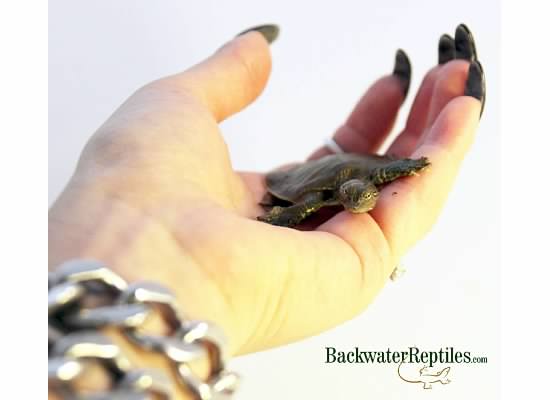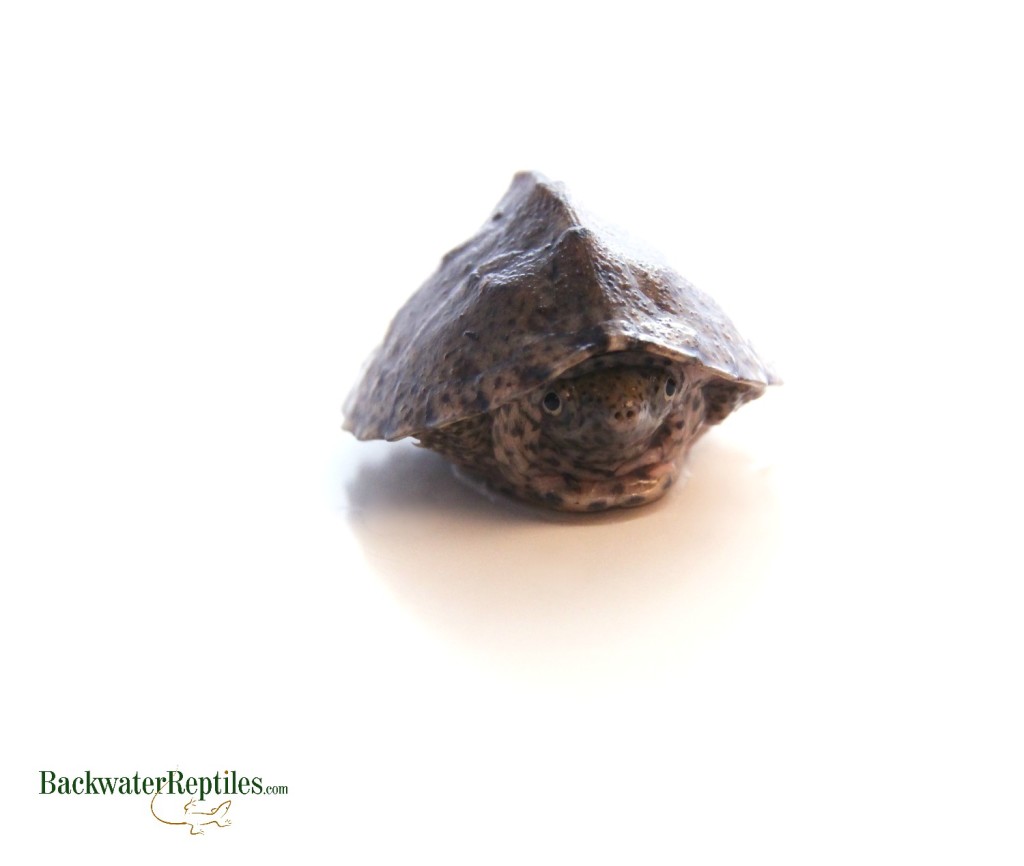Personally, we think that all species of turtles make wonderful pets, whether they live mainly aquatic existences or prefer to live on land. However, for the purposes of this blog article, we will focus on detailing our top four aquatic turtle species that spend a great deal, if not most of their lives, in water.
Red Eared Slider (Trachemys s. elegans)
Probably the most common turtle sold in the U.S. at pet stores and from breeders is the red eared slider. These turtles make great classroom pets and are also great for outdoor pond enclosures.
Fun fact: red eared sliders get their names from the red ear patches located on both sides of their heads. While basking, they are also known for quickly sliding or scooting into the water if any perceived threat appears.

Keep in mind that red eared sliders start out very small as hatchlings, but will grow into a rather large-sized adult turtle. Hatchlings are anywhere from the size of a quarter to a silver dollar, whereas an adult turtle will average around twelve inches long.
Red eared sliders are very strong swimmers and will spend most of their time in the water, which means they will need a fairly large tank that holds water, just like all of the turtle species on this list. Make sure that there are plenty of spaces for the slider to exit the water and bask though, since they do enjoy soaking up the heat and UV rays.
Red eared slider turtles are very commonly available at pet stores, but you can also purchase one from Backwater Reptiles.
Eastern Spiny Softshell Turtle (Apalone spinifera)
Softshell turtles in general are flat, with snooty noses, and leathery, pancake-like shells. They get their common name from the pliable, soft nature of their shells.
The Eastern Spiny Softshell turtle is a brown, tan, or olive-colored turtle with dark speckles on its carapace. It’s shell is also trimmed around the circumference with small, spines, hence its common name.

Like the red eared slider, the spiny softshell turtle will grow quite large and will require a large, aquatic enclosure at maturity. It should be noted that a big difference between the enclosures of a standard/non-softshell turtle and a softshell turtle is that a softshell’s tank shouldn’t have any hard, rough, or jagged surfaces that the turtle can brush against. Due to the soft nature of their carapaces, softshells can easily scratch themselves and even get infections, so you’ll want to make sure that all tank decor is smooth and unimposing.
You can have a spiny softshell turtle of your very own. Purchase today from Backwater Reptiles.
Reeves Turtle (Mauremys reevesii)
We recommend Reeves turtles to hobbyists who would like an aquatic turtle with similar habits and care requirements as a slider, but who would like their turtle to stay small and manageable. Smaller turtle = smaller tank.
Reeves turtles are considered mid-size turtles. Very large adults have been reported to reach nine inches in length, but most won’t surpass six inches. Their life span is anywhere from ten to twenty years.

The diet of a Reeves turtle is simple. They are omnivores who are perfectly content to eat pre-packaged turtle pellets or frozen aquatic worm pellets like blood worms. They will also enjoy live insects such as night crawlers, crickets, or roaches.
Ready to bring home a mid-size turtle of your own? Backwater Reptiles sells Reeves turtles.
Razorback Musk Turtle (Sternotherus carinatus)
Of all the aquatic turtles on our list, we’d say that the razorback musk turtle is the shyest by nature. They prefer to hide out, whether that be in aquatic plants or in a hide designed specifically for them.
Razorbacks also have very interesting physical traits. They get their common name from a very distinctive sharp keel or ridge running down the center back of their carapace. Their skin color is beige or olive with dark polka dot-like accent spots.

Because musk turtles in general are not known to bask a lot, you can expect that your razorback will not come out to soak up UV rays all too frequently. However, as with all aquatic turtle species, it is an absolute necessity to provide areas where the turtle can completely emerge from the water if it so desires.
If you would enjoy a quiet, shy aquatic turtle, Backwater Reptiles sells hatchling Razorback Musk Turtles.
Conclusion
If you enjoy aquatic set ups and you want to add a pet turtle to your home, we feel that any of the turtles on this list would be great to start out with.
Each of these aquatic turtles has its own unique physical traits and habits, but we think that each is just as rewarding a pet as the last.
